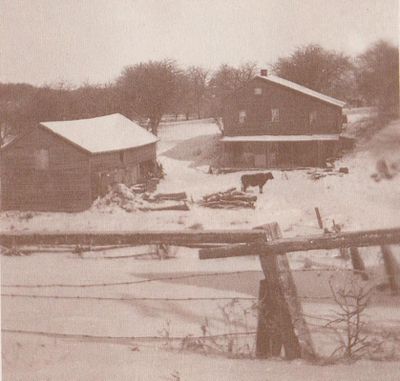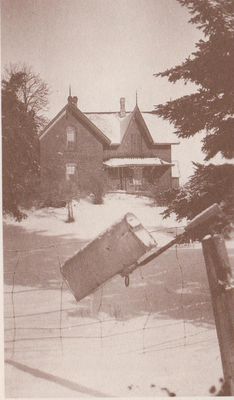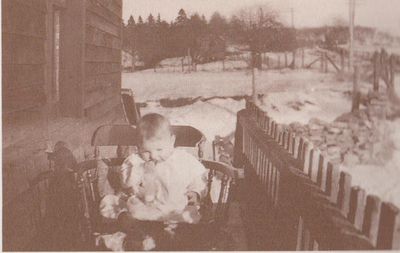
Sharon Community
Sharon Community

Photograph of Sharon (Edville) blacksmith shop Details
In the pioneer days these wooded slopes, which lie midway between Brighton and Colborne and three miles north were covered with virgin forest. The first settlers built their homes of hand hewn logs. Then to make a clearing for cultivation the giant trees were felled. The logs were cut into cordwood drawn to Brighton and sold to the Grand Trunk Railway at two dollars and fifty cents a cord as all locomotives were driven by engines fired with wood.
Roads were chartered out to lay the county into townships. When they were run through swamps, logs were lain crosswise and sunk in the mud until they rose above the surface. These were called corduroy roads. Such a one was built just east of the school through a swamp near Factory Creek. Bits of the old corduroy logs often lie exposed above the gravel covering.
Little Lake extends over an area of two hundred acres surrounded by maple and cedar wooded slopes fed by springs from these hill sides. The road veers around this to the west. To the east a large cranberry marsh lay in the path of the right of way and thus the road was jogged again north of William Piddick. This marsh probably covers one thousand acres. It is thickly wooded with hardwoods and evergreens. In the central part is a bog of shallow water and quicksand bottom. In 1937 an old flying boat aeroplane with motor, back of wings made a forced landing here. They crashed in the top of a huge spreading tree which uprooted and broke the force of the fall. The plane was badly damaged but the men were uninjured. Dr. Rundle then Coroner had laboured to the scene of the accident after having been called by a neighbour. Luckily they didn’t alight on the water of the bog. The rescuers had to break withes and saplings to make a path to them and the plane’s motor was carried out stretcher style.
Orchids grow here in a secluded spot. Miss Hazel Farley used to make an annual pilgrimage to secure these precious delicate flowers. Her path was marked by newspapers stuck on the dead tamarack branches.
Social life consisted of gatherings in the school. Religious worship was held here too. The minister travelled a circuit of one hundred miles administering to the spiritual needs of the scattered settlers in turn befriended the minister by affording him shelter, food and transportation to the next school. In those days neighbours were neighbours helping with the building of the homes and barns. Husking bees, quilting parties, old-time square dances, spelling matches and concerts of home talent comprised their social life.
Today we enjoy the same pleasures but the car is the main mode of travel and adds outside places of entertainment. The first car introduced to this neighbourhood was owned by George McDonald in 1914.
The church of this community (Sharon United Church) was built in 1872 (the building no longer exists, but it was located across Telephone Road from the school, at the corner of Deele Road - the foundation only remains). The Episcopalian and Wesleyian amalgamated. The land for this was donated by E. T. Farrow’s father is now owned by E. Mahhall. E.T. Farrow did faithful service as the Superintendent of the Sunday School for twenty-five years, and Orton Purdy, father of Mrs. John Cochrane was Secretary for the same length of time, while Miss Annie Hinman, a blind girl capably acted as organist. During the same time Ed Hinman, Richard Chatten, Misses Nina and Alma Lacey, Mrs. Ross Walker and Maude Hoare were worth Sunday School Teachers.
Before this an Episcopalian Church was the place of worship on Mr. Reuben Waite’s place near the Waite cemetery which is about one hundred years old and a Wesleyian Methodist Church was about three miles west on Thomas Walker’s place.
At one time this community must have been quite flourishing. A blacksmith shop did considerable work for the farmers in the settlement under the capable hands of Messrs. Hicks, then Armstrong and later Barrett. This ship was on the north side of the road on a steep slope just west of Mr. A.T. Walker’s home.
A cheese factory by Factory Creek was built by the farmers of the community to accommodate their production of milk. Today the milk is trucked to Cedar Creek Cheese Factory on the Campbellford Gravel by Fred Irwin.
Just back of the factory is an old kiln which once made bricks for the erection of many building in the district.
A saw mill for the lumber industry and pulling mill which carded wool and fulled cloth was doing business on the Ira Brintnell place now owned by Ed Hoare.
Another saw mill was built by Mr. Yule across a creek flowing through his farm later owned by Sam Brown and then by George Gummer now by James Cochrane. It was built to saw into lumber the great pines which covered his property. This was hauled by horses to Cole’s Wharf and shipped to the States Great piles of good wood was burned in pioneer days just to make a clearing.
A store once did business in Mr. Fred Pearson’s house then owned by Charles Ireland. Since 1935 a store owned by Thomas Verity on the west shore of Little Lake has been doing a thriving business especially during the summer months when the campers their cozy cottages which cluster about the shores.
An evaporator for apple drying once did a flourishing business just east of the present school. Most the produce was shipped to Toronto. The foundation still stands.
When Ed Cochrane was a Federal Member of Parliament he named the settlement Edville and a Post Office distributed mail from Mr. Barrett’s house. But for some years the daily mail had been delivered to the box holders from Colborne. Mail drawer at present is Lloyd Vanslyke.
An old root cellar still shows its hump on the landscape on L. McDonald’s farm. This was an underground cellar supported by huge beams and rafters and entered by a thick wooden door considerably lower than the surface. This was all deeply covered with earth and preserved the roots then grown.
The community has many natural resources – the lake furnishes some good bass in summer, the ice-cutting industry flourishes in the winter.
Nearly every farm furnishes its own fuel and many have maple sugar bearing threes for their own use. Muskrat is trapped along Factory Creek by Ted Walker and the odd coon and fox is shot during the winter, while jackrabbits abound and furnish good eating. A new resident to Little Lake, Adrian Bender is introducing mink raising.
Some of the close residents to Cranberry marsh are able to procure a basket of cranberries and its features which are nearly impenetrable produce wild raspberries where the wood has been cut off the year before. Most farmers have an apple orchard and small fruit. They grow factory crops of tomatoes, corn, peas, pumpkins, onions, carrots and beans. Nearly all produce their own grain and hay for stock and store have surplus for sale.
The first crop of pea dusting by aeroplane in Canada was carried out over the fields of Sharon.
A spring of some renown bubbles from the ground from Mrs. A.A. Murphy’s place. It is walled in on the roadside and accommodates the passers-by. Sam Bennett and John Thorns constructed the first wooden trough. Later the council employed Sam Brown to make one of cement. Thus the community never lacks for spring water when the wells go dry. The spring furnishes those east and the Lake, those south and west.
Telephones were introduced in 1900. William Wade built the line. George Gummer later bought it and then the Cramahe Township afterwards controlled it.
Electric power was introduced to the community about 1938. John Cochrane and M.T. Farrow were the first consumers. It has made a revolution in the life of the farmers and his wife: electric lights were first installed then many bought milking machines, grinders, saws and water pumps. The housewife now has the luxury of washing machines, irons, electric stove, cleaners and refrigerators.
From the top of Drury Hill this fertile valley may be viewed. None other could be more picturesque. Little Lake nestles in its hollow. Trees in groves and laid out orchards, cultivated fields, a school and a church spire are all included in the rolling landscape dotted with farm homes and red barns. How could one ask for more? (by Mr. A.T. Walker and transcribed by Carole Reddick Ring, 1947 and published in How Firm a Foundation: A History of the Township of Cramahe and the Village of Colborne by Eileen Argyris, pp.101-103).

Photograph of the Walker home, Edville, ca. 1910 Details

Photograph of Edith Pearson, Edville Details
